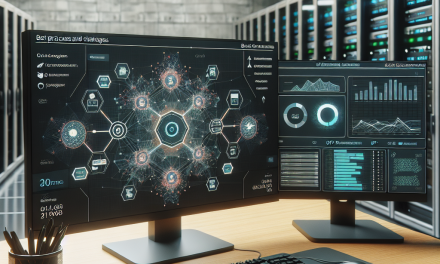In today’s fast-paced tech landscape, Kubernetes has emerged as a cornerstone for container orchestration, enabling businesses to deploy, scale, and manage containerized applications effectively. However, with great power comes great complexity. Debugging workloads in a Kubernetes environment poses unique challenges that require a systematic approach. In this article for WafaTech Blogs, we’ll explore effective debugging techniques to help you navigate the complexities of Kubernetes workloads.
Understanding Kubernetes Architecture
Before delving into debugging techniques, it’s essential to grasp the fundamental architecture of Kubernetes. At the core of Kubernetes are its key components:
- Master Node: Manages the Kubernetes cluster, coordinating how containers run across nodes.
- Worker Nodes: Hosts the actual running applications in containers.
- Pods: The smallest deployable units in Kubernetes, which can encapsulate one or more containers.
- Services: Abstracts access to Pods, ensuring stable endpoints.
Understanding this architecture helps in pinpointing where issues might arise.
Common Issues in Kubernetes Workloads
Identifying problems in a Kubernetes workload can be challenging due to the sheer number of moving parts. Common issues include:
- Application Crashes: Pods might terminate unexpectedly.
- Unresponsive Services: Services may fail to respond, impacting application availability.
- Resource Limitations: Misconfigured resource limits can lead to performance degradation.
- Networking Issues: Problems with pod-to-pod communication can arise.
Debugging Techniques
1. Logging
One of the first steps in debugging is to gather logs from your applications running in pods. Kubernetes integrates seamlessly with various logging solutions like ELK Stack, Fluentd, and others.
- kubectl logs: Use this command to fetch logs from specific Pods.
bash
kubectl logs
2. Describing Resources
The kubectl describe command is invaluable for gaining insights into various resources and understanding their state.
- Inspecting Pods: You can see the conditions, events, and status of your pods with:
bash
kubectl describe pod
3. Monitoring Resource Usage
Resource constraints can lead to performance-related issues. Utilizing Kubernetes metrics server or a third-party metrics solution like Prometheus can help in identifying bottlenecks.
- Check resource usage:
bash
kubectl top pods
4. Shell Access to Pods
Sometimes you need to interact directly with a running container for a deeper understanding. Using kubectl exec, you can access a shell in the pod.
bash
kubectl exec -it
5. Event Inspection
Kubernetes generates events that log the lifecycle of objects in your cluster. These can help trace the origin of issues.
- View events:
bash
kubectl get events –sort-by=’.metadata.creationTimestamp’
6. Network Debugging
Networking issues can be a significant source of problems in Kubernetes. Tools like kubectl port-forward can help access specific pods for further investigation.
- Port-forwarding:
bash
kubectl port-forward:
Using tools like curl or ping within the pod shell can help diagnose connectivity issues.
7. Visualizing with Dashboards
Using visual dashboards like Kubernetes Dashboard or Grafana can provide an overview of your clusters, making it easier to spot issues at a glance.
8. Utilizing Third-party Tools
Several third-party tools like K9s, Lens, and Weave Scope enhance Kubernetes experience and streamline debugging processes, offering interfaces designed for easier navigation and troubleshooting.
Best Practices for Kubernetes Debugging
- Keep Kubernetes Updated: Regularly update your Kubernetes version to benefit from the latest features and bug fixes.
- Use Health Checks: Implement liveness and readiness probes to help Kubernetes determine the health of your applications.
- Version Control: Maintain your configurations in version control systems like Git, which allows you to revert easily in case of issues.
- Document Findings: Keep a debug log of errors and resolutions for future reference and to aid team members.
Conclusion
Mastering debugging techniques in Kubernetes is an essential skill for developers and DevOps engineers alike. By employing a combination of logging, monitoring, and interactive troubleshooting methods, you can efficiently pinpoint issues and maintain robust Kubernetes workloads. As you deepen your knowledge and refine your skills, you will not only enhance your own efficiency but also contribute significantly to the resilience of your organization’s architecture.
Happy debugging!





